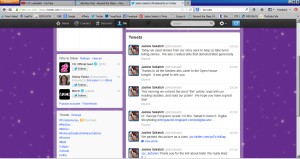
cc licensed ( BY ) flickr photo shared by Tim & Selena Middleton
A final reflection is a bit of a misnomer because the work of creating and supporting young learners in digital spaces will be part of my teaching practice from this day forward. My learning journey has begun but by no means have I reached the end of the road.

cc licensed ( BY ) flickr photo shared by daveynin
I am proud and comfortable with the steps that I have taken to become more aware of resources available to support young people online and the actions that I have taken so far to make their learning activities a success. Highlights of these step and blog posts that reflect and document the growth are below:
Updated classroom blog that includes a Twitter account
- The Strength of a Professional Learning Network
- The First Tweets from my Classroom
- Moving Froward by Starting to Make Connections in Grade 1/2
- The Middle Ground can be Murky; The Risk of Vulnerability
- Taking the First Steps
- The Filing Cabinet
Teach children to Tweet and comment on blog post.
We made a beautiful painting on canvas. We are proud of our painting. We painted the picture using team work. pic.twitter.com/jgLG1zY20Z
— Jackie Sakatch (@MrsSakatch) November 13, 2013
Develop and maintain a YouTube channel with my son.
Curate Digital Citizenship Resources for parents and teachers

cc licensed ( BY ) flickr photo shared by David Goehring
Next Steps
I plan to continue to use Twitter in my classroom. I want to expand the number of blogs that my students comment on and work with them to create entries for our classroom blog. Eventually I would like to connect with other classrooms through Skype. I am hoping to visit Kathy Cassidy’s classroom in the new year to see first hand how she supports her learners with technology and individual student blogs. Cory Antonini, our consultant stopped me in the hallway last week and mentioned that he had another teacher who would like to start to connecting their classrooms through Twitter and that he had another idea for me to try. I am excited to explore other learning opportunities. In the future I would like to explore creating individual student blogs or learning portfolios.
My son has numerous plans and ideas for his YouTube channel. I feel it is my job to support him but to also stay out of his way and allow him to create his own learning path. He has mentioned that he would like to create a playlist for his videos and wanting to create more videos where he interviews people. Perhaps he will create his own blog.
The Digital Citizen Resources LiveBinder that I have created is easy to use and I plan to continue to add content.
Final Thought

cc licensed ( BY ) flickr photo shared by Bart Everson







